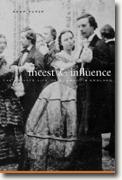Incest and Influence
Adam Kuper
book reviews:
· general fiction
· chick lit/romance
· sci-fi/fantasy
· graphic novels
· nonfiction
· audio books
· author interviews
· children's books @
curledupkids.com
· DVD reviews @
curledupdvd.com
newsletter
win books
buy online
links
home
for authors
& publishers
for reviewers

 |
Incest and Influence: The Private Life of Bourgeois England Adam Kuper Harvard University Press Hardcover 304 pages October 2009 |
|
Anthropologist Adam Kuper makes an extravagant claim at the beginning of this book exploring the propensity for British Victorians of the rising middle class to marry relatives. It is, he says, one of the great neglected themes of 19th-century history.
A relatively small number of “bourgeois clans,” the author argues, played a major role in Britain’s 19th-century ascent as an industrial and later an imperial power. Their preference for marrying within the family circle as a way of preserving wealth and cementing alliances helped propel Britain to a position of world domination. There is much to admire in this book. The author is enormously erudite and seems to have read every major - and many minor and all-but-forgotten - Victorian novels. Many of his examples come from the world of fiction, which reflected reality as the authors perceived it. He is an authoritative and breezy guide to the world he describes. One of the family alliances he examines concerns the Wedgewoods, who built a pottery and china empire and were linked through marriage to the Darwins, who gave the world Charles Darwin. The book begins with Darwin’s amusing list of the pros and cons of marriage. Among the pros: “object to be beloved & played with – better than a dog anyhow.” The Barclays and Freames were two banking families whose marriage links began in the 18th century and eventually gave birth to the Barclays Bank empire that still endures. The complex webs of marriages are diagramed through family trees, but they eventually became a little too much for this reader. One interesting sidelight illuminated here concerns the protracted battle around a provision in the law that prohibited marriage between a man and any of the sisters of his deceased wife. The reason behind that ban derived from a highly questionable Biblical interpretation that regarded husband and wife as "one flesh." Therefore, the sisters of a man's wife became like his own sisters. Marrying one of them after the death of a wife would be incestuous. At that time, when many women died young in childbirth or from other illnesses, men often turned to their wives' sisters for help in the household, and marriage was often seen as a convenient and desirable solution for all parties. Such marriages were common in the United States and in British colonies where they were legal. Lifting the ban in Britain, Kuper writes, was first mooted in 1842, and the debate raged for 65 years until Parliament finally passed the Deceased Wife's Sister's Marriage Act of 1907. (A ban against women marrying the brothers of their deceased husbands remained in place until 1921). One leading theologian warned that the very sacrament of marriage was at stake. "Those who deny that the sister is akin to the husband must deny that the husband and wife are really one, and so at once strike at the very root of the holiness and mysteriousness of marriage," he argued. It all sounds quite familiar in view of today’s battles over marriage. In the end, of course, the law passed, and today that heated debate is remembered only by historians. The book winds up with a description of the various affairs and entanglements of the Bloomsbury Group, already endlessly analyzed and picked over by other historians and lovers of the lurid. Cousin marriage virtually disappeared in the 20th century, Kuper says, partly because World War I killed so many marriageable men and partly because of falling birthrates, which meant fewer cousins were available. At the same time, other ways of generating and preserving wealth were found. Originally published on Curled Up With A Good Book at www.curledup.com. © Alan Elsner, 2010 |
|
|
|
 Click here to learn more about this month's sponsor! |
|
| fiction · sf/f · comic books · nonfiction · audio newsletter · free book contest · buy books online review index · links · · authors & publishers reviewers |
|
| site by ELBO Computing Resources, Inc. | |
 Kuper fails to fully substantiate that claim in this book, which painstakingly plots the way in which prominent families became intertwined for generations, chiefly through marriage between cousins. Despite its exaggerated premise, the book still provides interesting and valuable information of interest to history buffs and general readers who wish to broaden their knowledge of the Victorian age.
Kuper fails to fully substantiate that claim in this book, which painstakingly plots the way in which prominent families became intertwined for generations, chiefly through marriage between cousins. Despite its exaggerated premise, the book still provides interesting and valuable information of interest to history buffs and general readers who wish to broaden their knowledge of the Victorian age.